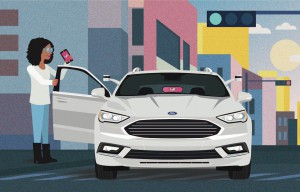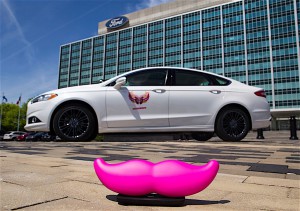
Ford is partnering with Lyft, which is partially owned by General Motors, to advance its self-driving vehicle technologies.
Ford Motor Co. will partner with Lyft, the country’s second-largest ride-sharing service, to begin fielding a substantial number of the driverless vehicles the automaker is developing by early in the coming decade.
Moving the driver out of the vehicle is a key goal for Lyft and rivals like Uber, the industry giant, because they compromise the single largest part of the cost of providing rides. Both companies are betting that if they can go driverless they can reduce prices to the point where it will be cheaper to hail a ride than to own a personal vehicle. But that strategy does raise concerns about the long-term impact on retail vehicle sales in the U.S. and other parts of the world.
“We know the technology has the potential to have a profound impact, but it’s time to look beyond the potential and talk about how it can be applied in helpful ways to create a viable business,” said Sherif Marakby, Ford’s vice president for autonomous vehicles and electrification.
Under Ford CEO Mark Fields, the second-largest of the Detroit automakers began investing heavily in advanced technologies, including autonomous vehicles. That included the $1 billion acquisition of San Francisco-based Argo AI.
(Ford planning temporary shutdowns at five North American plants. For the story, Click Here.)
This week’s announcement suggests that after completing a 100-day review of the carmaker’s strategies, new CEO Jim Hackett plans to continue focusing on self-driving vehicles. And for good reason, as most analysts believe the technology will become increasingly commonplace in the coming decade.
But Ford is taking a different tact from many of its competitors. Nissan, for example, hopes to have its first fully autonomous vehicle in production by 2020, and others are targeting similar timetables. But those vehicles are widely expected to still require an “operator” to be stationed at the controls, ready to take over in an emergency – or if the vehicle goes beyond specific, geo-fenced areas where it can no longer drive on its own.
Ford is targeting what is known in industry terms as Levels 4 and 5 autonomy. The goal is to come up with vehicles that never need human intervention and likely won’t even have steering wheel and pedals.
In announcing that strategy last year the automaker stressed that it may be impossible to expect a human to quickly and safely intervene, when needed, after a long drive. So, former global product development chief Raj Nair said, the company was focusing on developing vehicles that wouldn’t falter and thus wouldn’t need to have a human backup.
(Click Here for more about Ford’s commitment to driverless technology.)
But Ford raised plenty of eyebrows by promising to put that technology into production by 2021. The deal with Lyft suggests it is confident of meeting that target.
The deal also gives a lift to Lyft, the ride-sharing service trying to take advantage of the problems hammering rival Uber over the last year. That turmoil, which included allegations of sexual harassment, use of illegal software and the departure of co-founder and CEO Travis Kalanick, has cost Uber business and market share, much of it picked up by Lyft.
The smaller company has also received significant new investments, some from Ford’s cross-town nemesis General Motors, underscoring the way that traditional alliances and rivalries are bending under the pressures of an auto industry undergoing massive change.
For its part, Ford made it clear it doesn’t see the new deal as monogamous, either.
“One thing is certain. Self-driving technology will change the way business is done,” said Marakby. “To help us build a viable business, we intend to work with multiple partners in the coming months to understand what self-driving technology can enable when applied with a human-centered approach.”
(To see more about Lyft’s development of autonomous vehicle tech, Click Here.)
Ford is also struggling to understand what an era of low-cost ride-sharing could mean to its century-old business model. By many estimates, more than a quarter of the miles Americans clock on the road will come inside vehicles operated by services like Lyft and Uber and millions of consumers may simply abandon the personally owned vehicle. How to adjust for that shift to its business model could become a challenge just as tough as coming up with the algorithms to make that driverless vehicles run.

